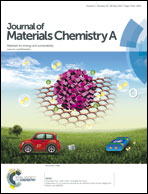Zn, Ga, and Ca substituted transition-metal-free oxides with K2NiF4 structures
Abstract
Recently, an oxide with K2NiF4 structure but free of transition metals was developed with the intent of creating a new solid electrolyte material. Here, the original composition, La1.6+xSr0.4−xAl0.4Mg0.6O4+x/2, was modified by replacing Sr, Al, or Mg, with the isovalent substitutes Ca, Ga, or Zn, respectively. The phase stability of these compounds was investigated to determine, specifically, the maximum concentration of oxygen defects allowed by the crystal structure. It was found that a greater concentration of oxygen vacancy defects than interstitials could be created in all of the compositions. In addition, the influence of the cation substitutions on the lattice parameters and the electrical conduction behavior was analyzed. At 650 °C in air, the highest conductivity achieved for B-site substituted compositions was 2.63 × 10−4 S cm−1 in La1.5Sr0.5Al0.4Zn0.6O3.9, much higher than 5.82 × 10−7 S cm−1 in La1.65Sr0.35Al0.4Mg0.6O4.025, while the highest value for A-site substituted compositions was only 7.55 × 10−7 S cm−1 in La1.65Ca0.35Al0.4Mg0.6O4.025. The electrochemical results indicated that A-site substituted compositions, although with low conductivity, were possible oxygen ion conductors, while B-site substituted compositions exhibited either mixed ionic and hole conductivity or pure hole conductivity.


 Please wait while we load your content...
Please wait while we load your content...